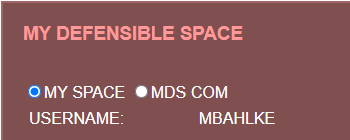MyDefensibleSpace Help Pages
What are we trying to do? We hope to create a dynamic map of the county showing areas where defensible space work has been done, and provide the ability to contrast that with areas where work is needed. To do this, simply show on the map the areas around your home where you have done defensible space work. This map shows 3 zones around the home, 5 feet, 30 feet, and 100 feet. In each area, indicate where you have done your work by clicking one of the radio buttons for the zones. 
Zone 1 = Five feetThis is the primary defense zone for every home. It is the last stand for fighting fire, and should be the first zone worked on to completion. Removal of combustible materials from the 5 foot zone will be very effective in reducing the risk of fire in surrounding areas spreading to your home. Stacked wood, combustible trash, tires, used oil, and other belongings all can create hazards in this zone. Also, flamable vegetation this close to a home is also hazardous. Replacing highly flamable plants with non-flamable decorations or landscaping will protect your home in the 5 foot zone. Zone 2 = Thirty feetThe second zone to reduce fire risk is the 30 foot zone. In this zone, reducing flamable objects and vegetation will reduce the risk of fire spreading close to your home. The main source of fire danger in this zone is from weeds and brush that are not cut or maintained. Cut weeds, reduce brush growth, and remove the debris to a safe distance before chipping or burning. This will create a "safe zone" around your home that will keep fire at a distance. Zone 3 = One Hundred feetThe one hundred foot zone is your defense against wildfire progression towards your home. Keeping vegetation at a minimum in this zone will prevent travel of fire, or reduce it to a controllable threat well before it gets close enough to threaten your home. While any fire on your property is a threat to your home, reducing the fire's ability to travel will minimize the risk to your home. Weed cutting, and tree trimming are of primary importance in this zone. Taking a close, critical look at all vegetation, and determining what to keep and what to replace or eliminate will help minimize fire risk, and maximize safety. While there is no perfect guarantee of fire safety in the Wildland Urban Interface, attention to detail in the three defense zones will minimize the threat to your home. More importantly, in the event of a wildfire, managing these spaces gives fire agencies the best help they can get to fight fires in your area, and on your property. They will have room they need to maneuver, and be able to have the upper hand when fighting actual fires in your space because that space has been managed properly. Once you have set the buttons for the work progress done, click on the submit button at the bottom of the left hand pane to save the results. Introductory instructional video: https://www.youtube.com/watch?v=3YDNkEW5_xM More to follow. |